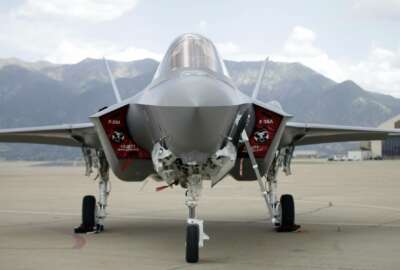
Air Force looking for innovation around simulators in upcoming Pitch Day
The Air Force is looking to duplicate the success of its recent pitch days later this year, with one focused on simulator technologies.
The Air Force is looking to duplicate the success of its recent pitch days later this year, with one focused on simulator technologies. Working with AFWERX, the Air Force’s in-house technology incubator, and the Small Business Innovation Research Fund, the Air Force Simulators Program Office plans to solicit proposals and award contracts to small businesses to improve its simulator technologies.
“We have a number of focus areas in our pitch day requests that we asked small businesses to propose options for us: how we can improve our simulator interoperability or artificial intelligence aided instruction, cutting edge display technologies, lightweight open architecture simulators, performance based training, data collection analysis,” said Maj. Patrick Kawonczyk, who will be running the pitch day event in December. “These are all opportunities for small businesses to utilize some of these commercially available innovative technologies, and then use those for military applications. So all the small businesses that applied for our pitch day request, they don’t typically work with the military. And this is their opportunity to come start working with simulators.”
The Air Force awarded $3.5 million to 51 companies during the first Pitch Day, which will grow in installments to $8.75 million. Before the day itself, the Air Force gave out even more funds to small and emerging businesses. It awarded 122 phase 1 contracts worth $6 million and 69 phase 2 contracts totaling $60 million. That’s a grand total of 242 contracts worth $75 million.
A phase one contract is the customer discovery phase. Those contractors will spend 90 days researching and networking, learning what capabilities they can apply to problems the Air Force would like to solve. Phase one will wrap up with a report, essentially a whitepaper. Then the Air Force reviews those reports, and gives these contractors the opportunity to make a phase two proposal. That may take the form of an actual prototype. Then phase three is where the company would actually field a solution.
One of the things the Air Force is looking for a company to help resolve is interoperability issues among its various simulator platforms.
“We have a variety of United States Air Force platforms. And they operate on a network,” said Kawonczyk. “And you know, one platform is built by one contractor another platform simulator is built by another defense contractor. And so when you, for example, look down through the clouds, one simulator, you may be able to see the ground, another simulator, you may not be able to see the ground, because the clouds are not being displayed the same on each simulator. So there’s a challenge there with getting multiple defense contractors to work together and play nice together.”
Performance-based training analytics is another capability the Air Force is looking to develop, so that it can take a closer look at how trainees perform in the simulators, identify trends, and find new ways to resolve common issues.
“So if you have that insight, that level of understanding about how well the student’s performing in a simulator, you can also look at how well that student performs in an airplane and you can make comparisons,” said Col. Philip Carpenter, senior materiel leader at the Air Force’s Simulators Program Office. “And there could even be cases where you might have a group of students going through training, and you might find that one student could be proficiency advanced, whereas another student might need a little bit more focused training, maybe in a specific area.”
There may even be a space for AI to enhance these capabilities.
“So if you can use artificial intelligence, to sort of help tease this out,” Carpenter said. “Maybe an instructor didn’t see this, but you could start to see a correlation across the entire student population or even instructor population.”
Copyright © 2025 Federal News Network. All rights reserved. This website is not intended for users located within the European Economic Area.
Daisy Thornton is Federal News Network’s digital managing editor. In addition to her editing responsibilities, she covers federal management, workforce and technology issues. She is also the commentary editor; email her your letters to the editor and pitches for contributed bylines.
Follow @dthorntonWFED
Related Stories




